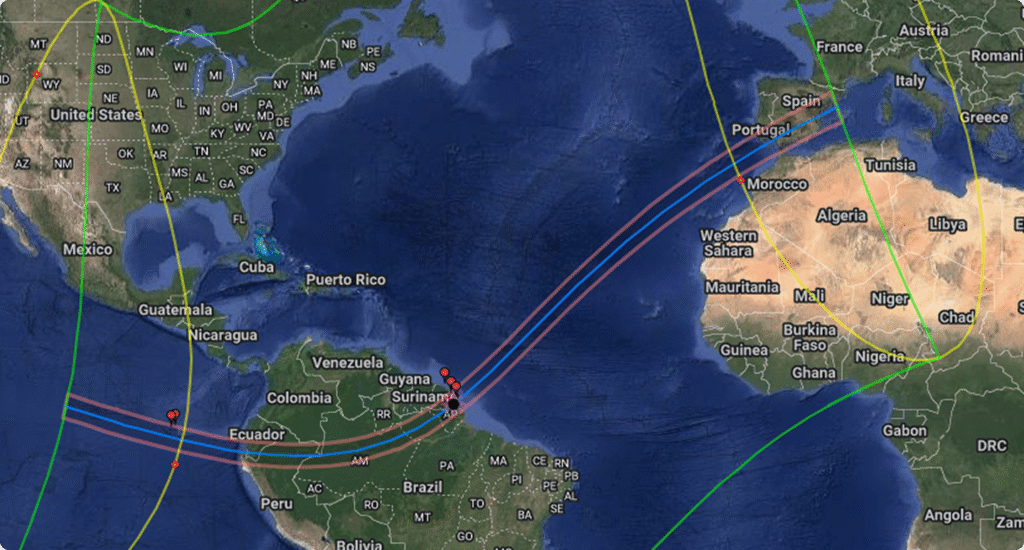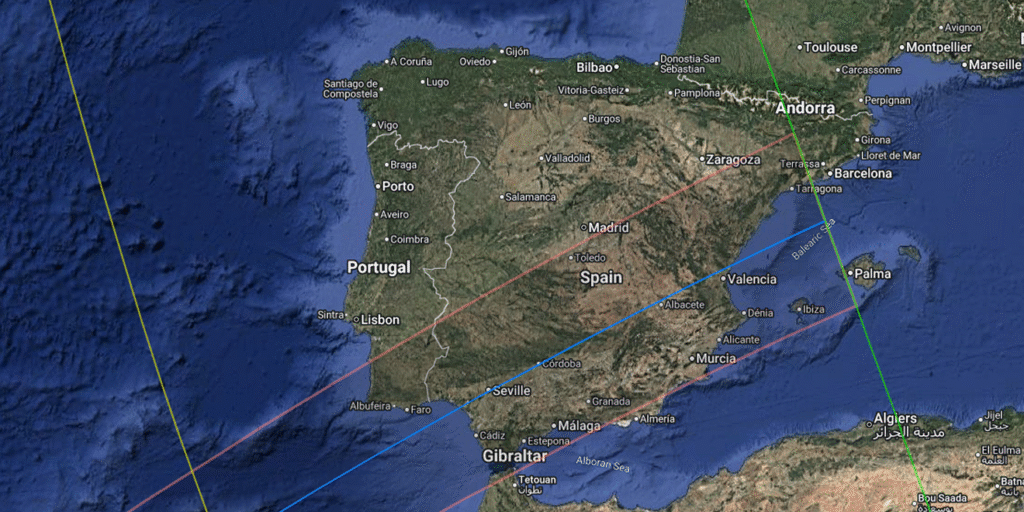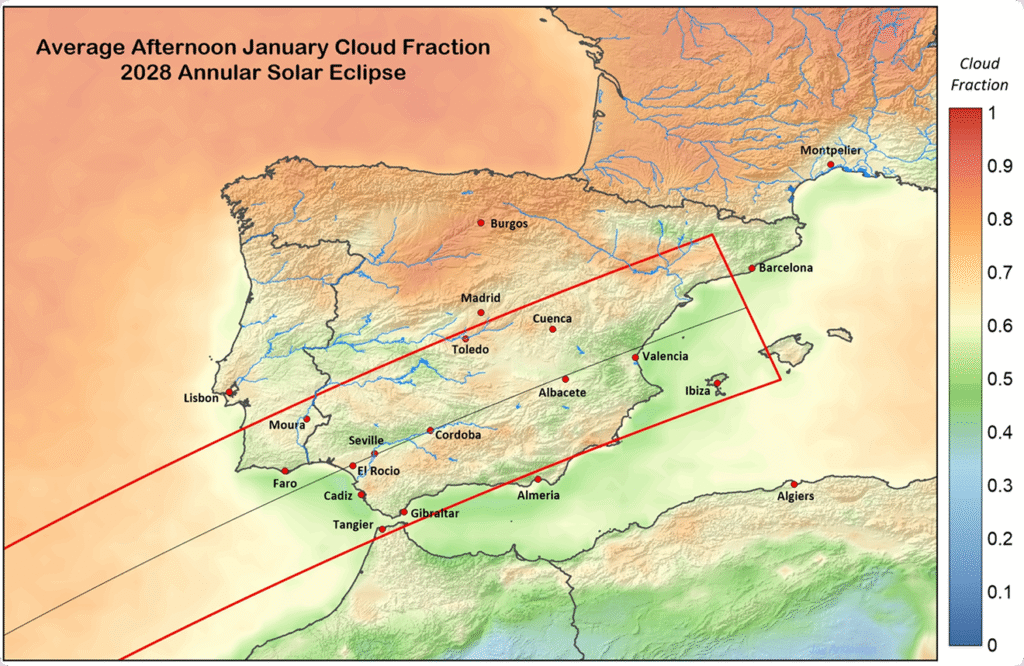Annular Solar Eclipse in Spain - January 26, 2028

The Annular Solar Eclipse of 26 January 2027 – The longest ‘Ring of Fire’
After two extraordinary total solar eclipses visible from Spain, the country will now witness a different celestial marvel: an annular solar eclipse, commonly known as the “ring of fire.”
This eclipse will occur on 26 January 2028 and will be observable from three main land regions: the Galapagos Islands, the northern part of South America (notably Ecuador, Peru, and Brazil), and Spain.
For Spain, this will be the third eclipse in just three years. Following the breathtaking total eclipses of 2026 and 2027, the skies will now offer an annular eclipse of remarkable beauty.
The longest view of the “ring of fire” within Spanish territory will occur at Playa de Castilla, lasting 7 minutes and 16 seconds. Seville, located further inland, will enjoy 7 minutes and 8 seconds, while Cádiz to the south will see 6 minutes and 37 seconds. Meanwhile, Mallorca, which experienced a sunset totality in 2026, will once again provide a spectacular show, this time with the annular eclipse setting over the Mediterranean.
Across much of Spain, particularly along the southwestern coast, the phenomenon will be visible at only 5 to 7 degrees above the horizon.
Annular Solar Eclipse 2028 in Spain
A spectacle at sunset
One of the most striking features of this eclipse will be its timing. The “ring of fire” will appear just before sunset, low above the horizon, creating a scene of rare beauty. To fully appreciate the event, observers must choose a site with an unobstructed western horizon, free from buildings, mountains, or other obstacles.
A rare coincidence of eclipses in southern Spain
This annular eclipse will take place just six months after the total solar eclipse of 2 August 2027. Remarkably, certain areas of southern Spain—such as Málaga, Cádiz, and Tarifa—will experience both astronomical events in a very short time frame: first a total eclipse, followed by an annular one. Such a coincidence is extremely uncommon and highlights southern Spain as an exceptional location for eclipse enthusiasts.
A unique occasion until 2059
Once the 2028 annular eclipse has passed, Spain will not witness another annular eclipse until 2059. That event, however, will only be visible from a small part of Catalonia. Consequently, the 2028 eclipse represents a unique nationwide opportunity that will not occur again for decades.
Path of the 2028 annular solar eclipse in Spain

The path of the 2028 annular solar eclipse will cross Spain from the southwest toward the northeast, with the central line passing directly over Seville, Córdoba, Albacete, and ending near Valencia.
The band of annularity – the area where the ring of fire will be visible – about 325 km wide, will cover much of Spanish territory and a corner of southeastern Portugal. Major cities along this track include Cádiz, Mérida, Granada, Murcia, Toledo, Cuenca, and much of the Mediterranean coastline—Tarifa, Marbella, Málaga, Alicante, and Valencia.
Madrid, although just outside the annular path, will still experience an impressive partial eclipse. Barcelona, in contrast, will see the phenomenon as the Sun nears the horizon, resulting in only a partial ring of fire. Even so, it remains a remarkable sight.
Despite its broad coverage, observation will be subject to cloud conditions and line of sight. As with the 2026 eclipse, the event coincides with sunset, and the Sun will be positioned very low in the sky.

Cloud and Weather Patterns Across Spain for the 2028 annular Solar Eclipse

Historically, January is one of Spain’s cloudiest months, with regional variations. Northern areas usually experience heavier cloud cover, while southern and coastal regions enjoy more winter sunshine.
Weather data, including information from Weather Spark, illustrates how cloud coverage can differ dramatically across Spain and that clearer skies—defined as clear, mostly clear, or partly cloudy—are more common in the south.
Cloud maps reveal that January conditions are considerably cloudier compared to the August eclipses of 2026 and 2027. As the eclipse concludes at sunset over Spain, observers must contend with significant winter cloudiness. Average cloud cover along the eclipse track ranges between 50% and 75%. Terrain plays a role, with lower cloudiness generally found on south-facing mountain slopes, influenced by downslope winds.
For instance, near Seville in the Guadalquivir Valley, clearer conditions are often found just north of the city, near the Sierra Morena. Though differences are modest—8 to 10 percent—they can be crucial. Córdoba, being higher and in a narrower valley, shows smaller improvements when relocating. Valencia, benefitting from its coastal position and nearby mountains, can also experience reduced cloudiness. Cádiz, influenced by the Gulf of Cádiz, records the lowest average cloudiness along the centerline, around 45%.
Overall, southern Spain tends to fare better, with sunnier conditions in mountain areas such as the Sierra Nevada (Granada and Almería) and Sierra Morena (Seville). Valencia and Ibiza also present promising conditions, although the Sun’s very low altitude during the event is a limiting factor.
Terrain and unobstructed view
Because the eclipse coincides with sunset, with solar altitudes ranging from 7.8° in Cádiz to nearly 0° in Barcelona, selecting a site with a wide, clear view to the west is essential.
Elevated spots such as hills or mountain ridges overlooking expansive flat terrain toward the west offer the best chances for a full view of the annular phase.
Best places to watch the 2027 solar eclipse in spain
| City | Start of the Eclipse | Start Total Eclipse | End Total Eclipse | End of eclipse | Sun Altitude at Maximum | Duration Totality | Cloud probability | Average Temperature August |
|---|---|---|---|---|---|---|---|---|
| Tarifa | 9:40:53 | 10:45:08 | 10:49:48 | 10:00:45 | 38.1° | 4m 39s | 14% | 28°C |
| Área recreativa Montera del Torero | 9:41:02 | 10:45:27 | 20:30:29 | 20:32:08 | 38.2° | 4m 15s | 13% | - |
| Sotogrande | 9:41:15 | 10:45:52 | 20:30:29 | 20:32:08 | 38.5° | 4m 08s | 16% | 29°C |
| Parque natural los Alcornocales | 9:41:05 | 10:45:40 | 20:30:29 | 20:32:08 | 38.1° | 3m 51s | 9% | - |
| Estepona | 9:41:26 | 10:46:19 | 20:30:29 | 20:32:08 | 38.6° | 3m 40s | 7% | 30°C |
| Sitio de Calahonda | 9:41:45 | 10:46:56 | 20:30:29 | 20:32:08 | 39.0° | 3m 26s | 13% | 30°C |
| Marbella | 9:41:40 | 10:46:50 | 20:30:29 | 20:32:08 | 38.9° | 3m 18s | 8% | 30°C |
| Cadiz | 9:41:45 | 10:45:22 | 20:30:29 | 20:32:08 | 37.5° | 3m 02s | 13% | 28°C |
| Torremolinos | 9:42:00 | 10:47:38 | 20:30:29 | 20:32:08 | 39.3° | 2m 42s | 12% | 29°C |
| Malaga | 9:42:07 | 10:48:09 | 20:30:29 | 20:32:08 | 39.3° | 1m 53s | 10% | 30°C |
| Jerez de la frontera | 9:40:58 | 10:46:17 | 20:30:29 | 20:32:08 | 37.6° | 1m 40s | 9% | 34°C |
If you know of ideal spots to watch the eclipse, please share them with others in the Discussion group below.
Please add photos, coordinates, anything you like.

